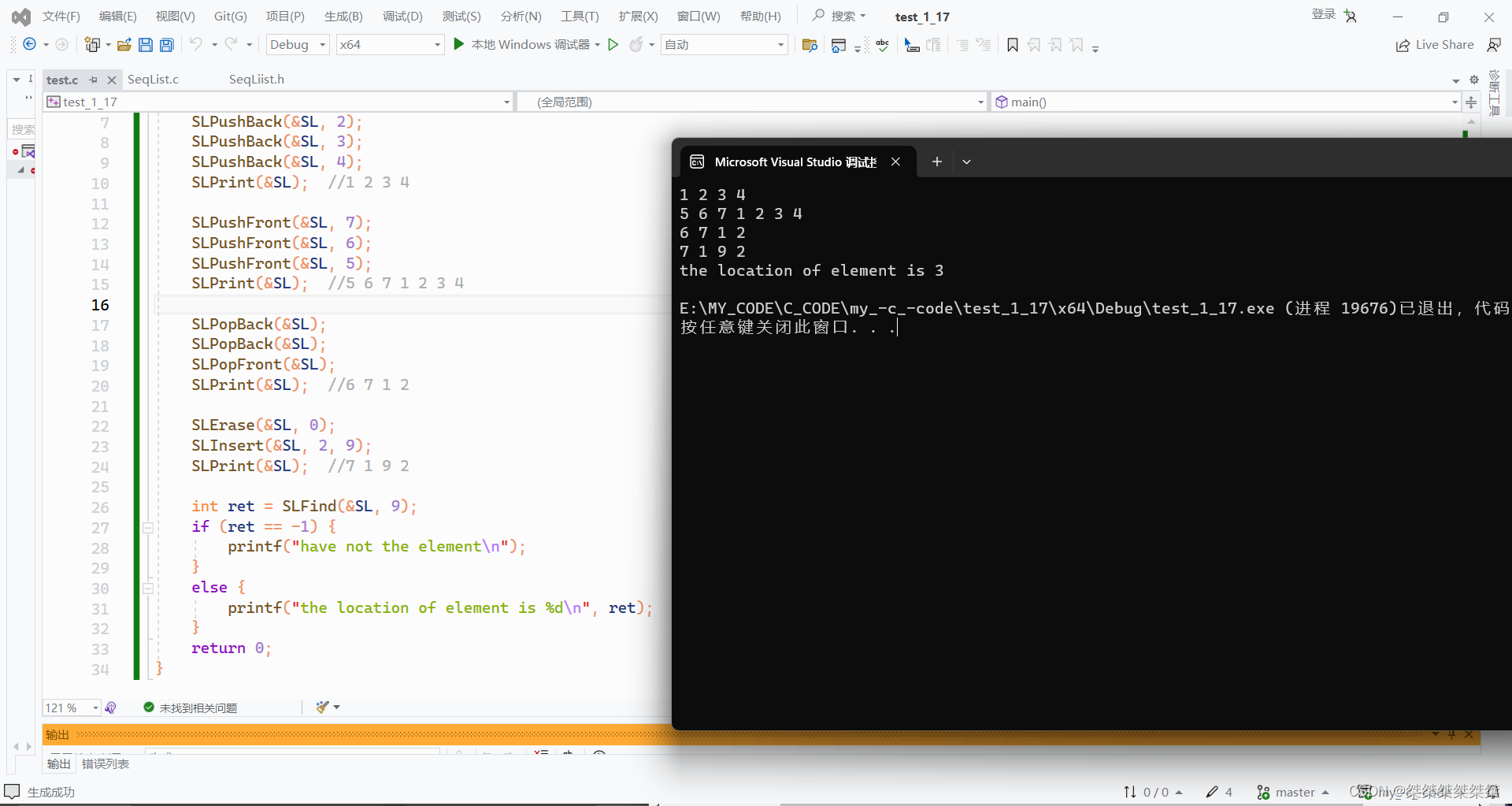顺序表(C/C++)
发布时间:2024年01月17日
? ? ? ? 本篇将讲解一些关于顺序表的内容,顺序表分为静态顺序表和动态顺序表,其中经常用到的为动态顺序表,所以本篇将以动态顺序表为重点给出一些关于动态顺序表的操作。
? ? ? ? 因为顺序表的实现逻辑较为简单,对于代码的讲解大多以注释给出。
1.顺序表相关操作
? ? ? ? 以下包括顺序表的抽象类型定义、两种顺序表的定义方式、以及一些相关操作:
#include <stdio.h>
#include <stdlib.h>
#include <assert.h>
//元素类型
typedef int DataType;
//静态表元素个数
#define MAX_SIZE 10
//静态顺序表
typedef struct {
DataType arr[MAX_SIZE];
int size;
}SL;
//动态顺序表
typedef struct {
DataType* arr;
int size;
int capacity;
}SqList;
//顺序表初始化
void SLInit(SqList* ps);
//顺序表尾插/头插
void SLPushBack(SqList* ps,DataType x);
void SLPushFront(SqList* ps, DataType x);
//顺序表尾部删除/头部删除
void SLPopBack(SqList* ps);
void SLPopFront(SqList* ps);
//指定位置之前插入/删除数据
void SLInsert(SqList* ps, int position, DataType x);
void SLErase(SqList* ps, int position);
//在顺序表中找到相关的元素
int SLFind(SqList* ps, DataType x);
//打印顺序表
void SLPrint(SqList* ps); 2.顺序表的插入与初始化?
? ? ? ? 顺序表的插入包括头插和尾插,头插就是在顺序表的第一个元素位置插入,尾插就是在最后一个元素后面插入。
//顺序表的初始化
void SLInit(SqList* ps) {
ps->arr = NULL;
ps->capacity = 0;
ps->size = 0;
}
//检查顺序表的当前容量
void SLCheckCapacity(SqList* ps) {
if (ps->capacity == ps->size) {
//三目操作符对容量进行分配
int newCapacity = (ps->capacity == 0) ? 4 : 2 * ps->capacity;
DataType* newBase = (DataType*)realloc(ps->arr, newCapacity * sizeof(DataType));
if (newBase == NULL) {
perror("realloc:");
exit(1);
}
ps->arr = newBase;
ps->capacity = newCapacity;
}
}
//头插
void SLPushFront(SqList* ps, DataType x) {
SLCheckCapacity(ps);
int count = ps->size;
//将所有元素都向后移一位
while (count != 0) {
ps->arr[count] = ps->arr[count - 1];
count--;
}
ps->arr[count] = x;
ps->size++;
}
//尾插
void SLPushBack(SqList* ps,DataType x) {
SLCheckCapacity(ps);
ps->arr[ps->size] = x;
ps->size++;
}3.顺序表的删除?
? ? ? ? 以下为顺序表的头部删除和尾部删除。
//尾删
void SLPopBack(SqList* ps) {
//检查顺表是否存在,以及容量是否为0
assert(ps);
assert(ps->size);
ps->size--;
}
void SLPopFront(SqList* ps) {
assert(ps);
assert(ps->size);
//将所有元素都向前覆盖
for (int i = 0; i < ps->size - 1; i++) {
ps->arr[i] = ps->arr[i + 1];
}
ps->size--;
}4.顺序表的指定插入与删除
? ? ? ? 以下的代码对指定位置的插入与删除:
//指定位置插入
void SLInsert(SqList* ps, int position, DataType x) {
//判断位置是否合法
assert(position >= 0 && position <= ps->size);
assert(ps);
for (int i = ps->size; i > position; i--) {
ps->arr[i] = ps->arr[i - 1];
}
ps->arr[position] = x;
ps->size++;
}
//指定位置删除
void SLErase(SqList* ps, int position) {
assert(ps);
assert(position >= 0 && position < ps->size);
//从指定位置开始往前覆盖
for (int i = position; i < ps->size - 1; i++) {
ps->arr[i] = ps->arr[i + 1];
}
ps->size--;
}5.顺序表的查找以及遍历?
? ? ? ? 顺序表的查找为在表中找到对应的元素,遍历就是将所有元素给打印出来:
//顺序表的遍历
void SLPrint(SqList* ps) {
assert(ps);
assert(ps->size);
for (int i = 0; i < ps->size; i++) {
printf("%d ", ps->arr[i]);
}
printf("\n");
}
//顺序表的查找
int SLFind(SqList* ps, DataType x) {
assert(ps);
assert(ps->size);
int i = 0;
for (i = 0; i < ps->size; i++) {
if (ps->arr[i] == x) {
return i + 1;
}
}
return -1;
}6.全部代码
#include <stdio.h>
#include <stdlib.h>
#include <assert.h>
//元素类型
typedef int DataType;
//动态顺序表
typedef struct {
DataType* arr;
int size;
int capacity;
}SqList;
void SLInit(SqList* ps) {
ps->arr = NULL;
ps->capacity = 0;
ps->size = 0;
}
void SLCheckCapacity(SqList* ps) {
if (ps->capacity == ps->size) {
int newCapacity = (ps->capacity == 0) ? 4 : 2 * ps->capacity;
DataType* newBase = (DataType*)realloc(ps->arr, newCapacity * sizeof(DataType));
if (newBase == NULL) {
perror("realloc:");
exit(1);
}
ps->arr = newBase;
ps->capacity = newCapacity;
}
}
//尾插
void SLPushBack(SqList* ps,DataType x) {
SLCheckCapacity(ps);//检验容量
ps->arr[ps->size] = x;
ps->size++;
}
//头插
void SLPushFront(SqList* ps, DataType x) {
SLCheckCapacity(ps);
int count = ps->size;
while (count != 0) {
ps->arr[count] = ps->arr[count - 1];
count--;
}
ps->arr[count] = x;
ps->size++;
}
void SLPrint(SqList* ps) {
assert(ps);
assert(ps->size);
for (int i = 0; i < ps->size; i++) {
printf("%d ", ps->arr[i]);
}
printf("\n");
}
void SLPopBack(SqList* ps) {
assert(ps);
assert(ps->size);
ps->size--;
}
void SLPopFront(SqList* ps) {
assert(ps);
assert(ps->size);
for (int i = 0; i < ps->size - 1; i++) {
ps->arr[i] = ps->arr[i + 1];
}
ps->size--;
}
void SLInsert(SqList* ps, int position, DataType x) {
assert(position >= 0 && position <= ps->size);
for (int i = ps->size; i > position; i--) {
ps->arr[i] = ps->arr[i - 1];
}
ps->arr[position] = x;
ps->size++;
}
void SLErase(SqList* ps, int position) {
assert(ps);
assert(position >= 0 && position < ps->size);
for (int i = position; i < ps->size - 1; i++) {
ps->arr[i] = ps->arr[i + 1];
}
ps->size--;
}
int SLFind(SqList* ps, DataType x) {
assert(ps);
assert(ps->size);
int i = 0;
for (i = 0; i < ps->size; i++) {
if (ps->arr[i] == x) {
return i + 1;
}
}
return -1;
}
int main() {
SqList SL;
SLInit(&SL);
SLPushBack(&SL, 1);
SLPushBack(&SL, 2);
SLPushBack(&SL, 3);
SLPushBack(&SL, 4);
SLPrint(&SL); //1 2 3 4
SLPushFront(&SL, 7);
SLPushFront(&SL, 6);
SLPushFront(&SL, 5);
SLPrint(&SL); //5 6 7 1 2 3 4
SLPopBack(&SL);
SLPopBack(&SL);
SLPopFront(&SL);
SLPrint(&SL); //6 7 1 2
SLErase(&SL, 0);
SLInsert(&SL, 2, 9);
SLPrint(&SL); //7 1 9 2
int ret = SLFind(&SL, 9);
if (ret == -1) {
printf("have not the element\n");
}
else {
printf("the location of element is %d\n", ret);
}
return 0;
}7.测试?

文章来源:https://blog.csdn.net/m0_74830524/article/details/135651760
本文来自互联网用户投稿,该文观点仅代表作者本人,不代表本站立场。本站仅提供信息存储空间服务,不拥有所有权,不承担相关法律责任。 如若内容造成侵权/违法违规/事实不符,请联系我的编程经验分享网邮箱:chenni525@qq.com进行投诉反馈,一经查实,立即删除!
本文来自互联网用户投稿,该文观点仅代表作者本人,不代表本站立场。本站仅提供信息存储空间服务,不拥有所有权,不承担相关法律责任。 如若内容造成侵权/违法违规/事实不符,请联系我的编程经验分享网邮箱:chenni525@qq.com进行投诉反馈,一经查实,立即删除!
最新文章
- Python教程
- 深入理解 MySQL 中的 HAVING 关键字和聚合函数
- Qt之QChar编码(1)
- MyBatis入门基础篇
- 用Python脚本实现FFmpeg批量转换
- 用selenium进行自动化测试
- Linux开机自动挂载window密码有转义字符的共享文件夹
- 使用vite创建vue3项目
- 2085. 统计出现过一次的公共字符串(Java)
- [蓝桥杯 2018省赛]回家路费
- matplotlib实现复杂子图布局
- R语言【paleobioDB】——pbdb_collections():通过参数选择,返回多个采集号的基本信息
- DBeaver 连接mysql 报错 Public Key Retrieval is not allowed
- UE5.1保存资源报错
- AI智能电销器人需要注意哪些问题呢